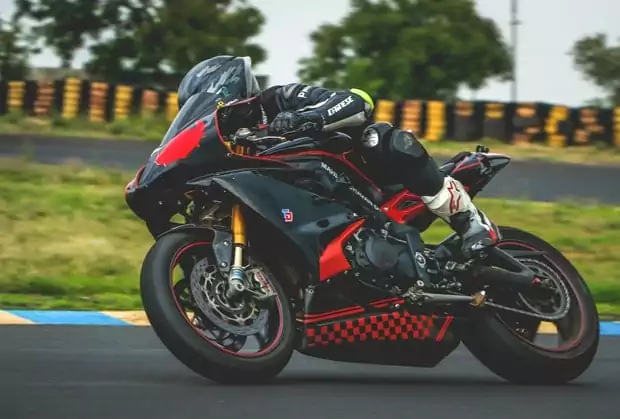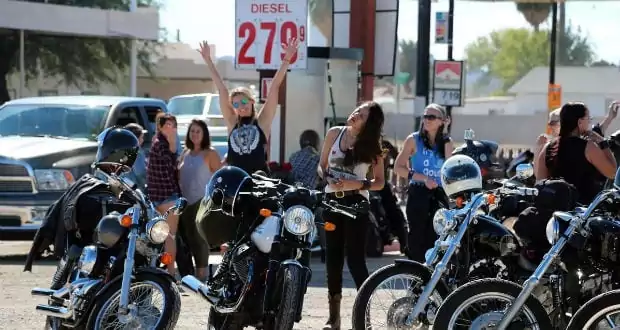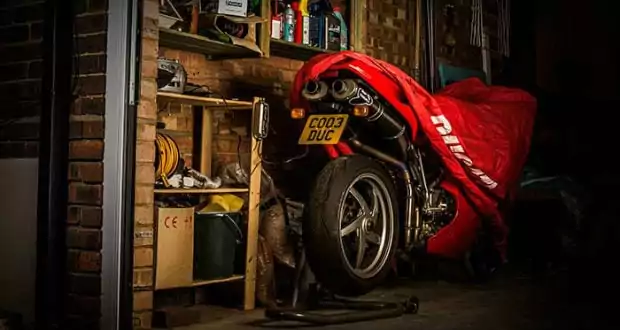Unfortunately, bad advice spreads through the motorcycle world like an epidemic. Misinformation is a problem faced by a lot of passion-based niche groups and motorcyclists are definitely not immune to it. New riders soak up the bad info like bad habits, treat it as gospel without question, and then carry it with them and apart their “wisdom” on the next wave of new riders.
I know one motorcyclist with more years riding than hairs left on his head, who still does everything wrong. We need to stop this vicious cycle! So I’m going to address the most common bad advice I hear, and explain why it’s wrong.
1) Change your motorcycle oil before winter storage
Are oil changes good? Yes. Should you spend time and money on an oil change before storing your motorcycle in the cold for months? No.
Taken from my article on How To Prepare Your Motorcycle for Winter Storage:
Let’s think about it. You’re spending money on oil and on a new filter, and maybe even on labour at a shop, plus your own time to get this done, right? So you get the fresh oil in. Now what? You run the bike for a moment, it gets hot. Then it gets progressively colder. Some days are above freezing. Other days are below. Some days are dry. Some days are raining. And still the bike sits.
What’s happening around that oil? Condensation. Moisture. Stuff that you don’t want getting into your oil! How do you get rid of it? You do an oil change in the spring time and put fresh oil in! So now it’s spring time, and you’re doing an oil change, and you’re wasting money again, and wasting time again… Wouldn’t it have been better if you had only done this once?
Do your oil change in the spring, people. Not the fall. Your wallet, and more importantly, your motorcycle, will thank you.

2) Sand your new motorcycle tires to break them in and be safe
Your friend’s master plan is dumb. I get the thought process. New tires have a sort of top-coat layer to them that’s actually very slippery. There’s even a guy working for the tire manufacturers who’s job it is to put a little warning label on every tire that says: “DO NOT GO BALLS TO THE WALL FOR THE FIRST 100 KM, ESPECIALLY NOT IN THE RAIN.”
However, our idiot buddy believes that by taking fine sandpaper (coarse if he’s a really special idiot) to his tires, he’ll avoid a disastrous wipe out… Wrong.
In addition to having a guy with label maker working for them, manufacturers like Pirelli, Metzeler, and Michelin also have geniuses in the building. Geniuses who have spent a lot of time calculating, engineering, and developing their motorcycle rubber to work through specific real-world wear patterns. I repeat. Your tires were developed for real-world wear patterns. Not for idiots with sandpaper. Put. It. Down. Jesse.
3) Empty your gas tank before winter storage
Also, emptying your tank is messy, a pain in the butt, can damage your fuel injectors if you’re running the bike, and all of that empty space leaves components like your gas tank susceptible to moisture coming in. And that moisture can cause corrosion.
Be smart. Spend the $5. Do it right. Also read How To Prepare Your Motorcycle for Winter Storage for other winter storage tips.
4) Lug your engine as low as possible to save money on gas
Without getting too technical, lugging your engine actually puts your motorcycle at a disadvantage. Yes, lower RPMs may result in better mileage, but lugging your engine means it actually has to work harder to do the same amount of work. Your motorcycle will be running less efficiently and your engine temperature will increase.
I’d say for every dollar you are saving, you’d be spending $10 more in maintenance. Don’t do this.
5) Use Fast Start to start your carbureted motorcycle in the winter
Again, without getting too technical, QuickStart (or Fast Start) is basically a high octane, pre-atomized, esther-based fuel mixture. Unless your air intake or filter is clogged, it’ll get your motorcycle started. You spray it for 1 to 2 seconds towards your airbox. It’s highly flammable, so when you hit the starter, your engine vacuum draws it into the cylinders, and it goes brap brap brap!
But here’s the thing: This stuff is hard on your engine. It’s to be used in a pinch, not repeatedly. If you have air, fuel, spark, and compression, even a motorcycle with carburetors should fire up no matter the temperature. If you’re needing to use it even once, you should already assume that you have a bigger problem that needs to be addressed. Look into getting your carburetor cleaned and properly jetted.
Read this article on How To Increase Motorcycle Fuel Economy if you want to know more.
6) Just start your motorcycle a couple times over the winter instead of charging your battery
First of all, what works for a car (with an alternator) won’t work for a motorcycle (with a regulator rectifier). They parts aren’t even the same! Your motorcycle’s charging system doesn’t pick up until you’re running the bike at far above idle, sometimes not until 5,000 RPM. Secondly, you’ll need to run it for long enough to get more of a charge in to the battery than the draw you just took out to start the bike in the first place. This could take a while!
Not only that, but running a bike in the cold for a long period of time wastes gas and also strips oil from important parts of your engine, like the cylinders and pistons. See, when it’s cold out, gas is less likely to evaporate, so your motorcycle runs rich (it adds more gasoline to the air-fuel mixture) to compensate. That extra fuel is a great solvent that can washes oil off the walls and lubrication off of the piston rings and cylinder liners. That can have some serious consequences to the overall health of your motor.
Just buy a battery charger. I’ve used a Battery Tender Jr. and a Ctek battery charger for about ten years each and love them both.
7) Just ride it to the mechanic
Bike isn’t running at it’s best? Just ride it to the mechanic’s, right? Wrong. If it’s gotten to the point where you already know something isn’t functioning as it should be, you’re probably already making the problem worse. Save your engine and your wallet some financial trouble and find a local motorcycle towing company like Motorcycle Towing Toronto.
Before we go
What are some common misconceptions or common bad advice you hear in the motorcycle world? Did I get anything wrong? Did I miss something big? Let me know in the comments section below.
PS: Not all misinformation comes from outside. You might also want to check out these 10 most common lies that motorcyclists tell themselves.
 YouMotorcycle Motorcycle Blog – Motorcycle Lifestyle Blog, MotoVlog, Motorcycle Reviews, News, & How-Tos
YouMotorcycle Motorcycle Blog – Motorcycle Lifestyle Blog, MotoVlog, Motorcycle Reviews, News, & How-Tos



I once encountered a friend of mine adding anti-freeze to his bike’s petrol tank for winter storage! I did point out that petrol does not usually freeze and that ethylene glycol is not supposed to be burnt but he was adamant it was the right thing to do! Come Spring when he fired it up, you should have seen the smoke! I then helped him drain and flush the entire fuel system and change his spark plugs as they were somewhat fouled as you might imagine! Now for the real irony. He was at the time an engineering apprentice! Somebody at work had given him the above advice!
Holy cow! Sounds like someone was messing with him when they gave him that little nugget of wisdom haha.
Oh I am sure it was a “wind up” by one of his work colleagues. I also tried to convince him that the word “Gullible” had been removed from the English Language, but he doubted that!
Here’s my piece of SOUND advice for the Spring fire-up. If your bike has a carb or carbs, DO NOT FIRE IT UP TILL YOU HAVE DRAINED THE FLOAT BOWLS AND FLUSHED THE LINE THROUGH WITH CLEAN PETROL. Yours truly forgot to do this last Spring. Rode thirty miles on my Harley then it suddenly cut out and was a bitch to restart. Every time I got it restarted, it would do another two miles then cut out again. Took me two hours to get it home and when I drained the float bowl, it was of course primarily full of water; condensation build up! GET RID OF IT FIRST, THEN ENJOY YOUR RIDE!!!!
Good tip! I’ve never done this with my carb’d bikes, but I have fired them up in the spring, and when they warmed up, just rang their little necks wide open on and off the highway. So far so good! Your way is probably a bit more technically sound haha.
Number 6. All bikes have alternators. That’s why you have a rectifier (to convert the ac pulses to dc). The reason that you should use a good charger instead of starting the bike in the winter is that unless you run the bike long enough to get the entire exhaust hot you will get condensation in the pipes and mufflers which will cause them to rot out in short order.
Where I live we don’t store our bikes for winter, we ride them. However I work away from home and during away time connect each bike to a battery monitor (not a charger) which trickles charge to maintain battery at optimum.
#4 used to be fact for old motorcycles but now riding at lower rpm is not the best way to get mileage. keeping your bike in shape is the best way to get maximum output from your bike. As you said in this article riding at lower rpm will result in excessive engine heating.